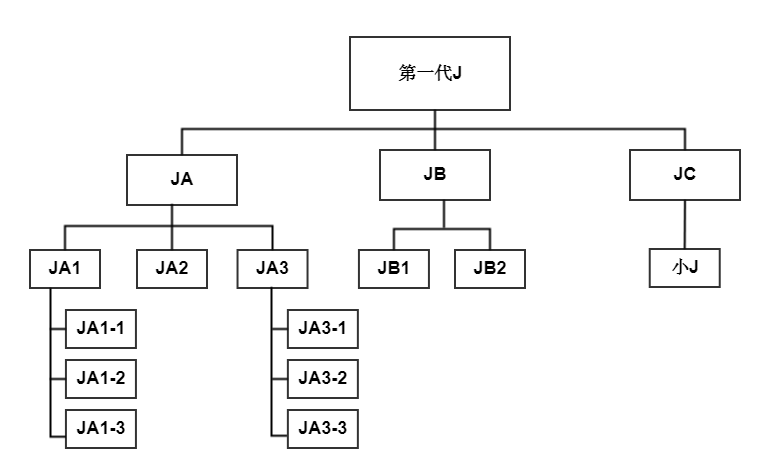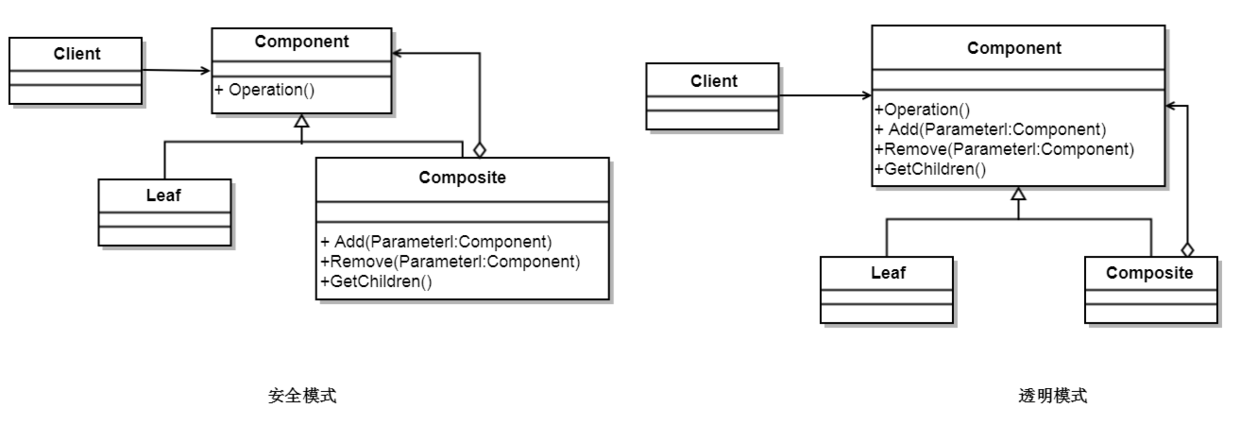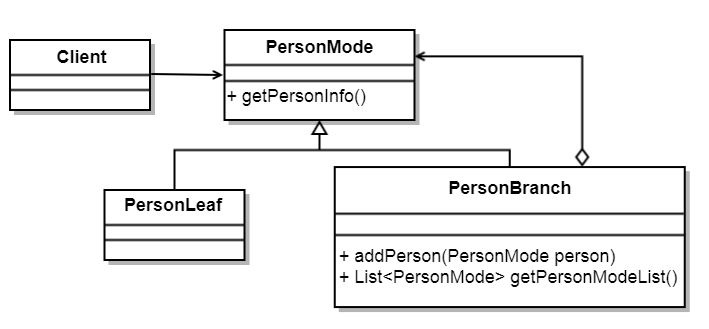小Y科普: 家谱又称族谱、宗谱等。它以记载父系家族世系、人物为中心,由正史中的帝王本纪及王侯列传、年表等演变而来。是一种特殊的文献,就其内容而言,是中国五千年文明史中具有平民特色的文献,记载的是同宗共祖血缘集团世系人物和事迹等方面情况的历史图籍。
Now,how to 实现 小J's 族谱。
一、小J族谱简略版

从最顶层的第一代J开始,一代代往下记录下去,这很明显就是一个树状结构,现在小Y要做的就是通过最合适的方式把小J的族谱图遍历出来。
二、树状图的拆解利器-组合模式
1.组合模式的定义
组合模式也叫合成模式,有时又叫做部分-整体模式,主要是用来描述部分与整体的关系,将对象组合成树形结构以表示“部分-整体”的层次结构,使得用户对单个对象和组合对象的使用具有一致性。
2.组合模式的角色介绍(组合模式有两种实现:安全模式和透明模式)

-
Component抽象构件角色
定义参加组合对象的共有方法和属性,可以定义一些默认的行为或属性。 -
Leaf叶子构件
Leaf叶子构件叶子对象,其下再也没有其他的分支,也就是遍历的最小单位。 -
Composite树枝构件
树枝对象,它的作用是组合树枝节点和叶子节点形成一个树形结构。组合模式的重点就在树枝构件。
3.组合模式的使用场景
-
只要是树形结构或者只要是要体现局部和整体的关系的时候,而且这种关系还可能比较深,就要考虑一下组合模式。
-
从一个整体中能够独立出部分模块或功能的场景。
-
维护和展示部分-整体关系的场景。
4.安全模式和透明模式的具体实现
(1)安全模式
①抽象构件
public abstract class Component {
//个体和整体都具有
public void operation(){
//编写业务逻辑
}
}
②树枝构件
public class Composite extends Component {
//构件容器
private List<Component> componentArrayList = new ArrayList<Component>();
//增加一个叶子构件或树枝构件
public void add(Component component){
this.componentArrayList.add(component);
}
//删除一个叶子构件或树枝构件
public void remove(Component component){
this.componentArrayList.remove(component);
}
//获得分支下的所有叶子构件和树枝构件
public List<Component> getChildren(){
return this.componentArrayList;
}
}
③树叶构件
public class Leaf extends Component {
/*
* 可以覆写父类方法
* public void operation(){
*
* }
*/
}
④Client
public class Client {
public static void main(String[] args) {
//创建一个根节点
Composite root = new Composite();
root.operation();
//创建一个树枝构件
Composite branch = new Composite();
//创建一个叶子节点
Leaf leaf = new Leaf();
//建立整体
root.add(branch);
branch.add(leaf);
}
//通过递归遍历树
public static void showTree(Composite root){
for(Component c:root.getChildren()){
if(c instanceof Leaf){ //叶子节点
c.operation();
}else{ //树枝节点
showTree((Composite)c);
}
}
}
}
(2)透明模式
①抽象构件
public abstract class Component {
//个体和整体都具有
public void operation(){
//编写业务逻辑
}
//增加一个叶子构件或树枝构件
public abstract void add(Component component);
//删除一个叶子构件或树枝构件
public abstract void remove(Component component);
//获得分支下的所有叶子构件和树枝构件
public abstract List<Component> getChildren();
}
②树枝构件
public class Composite extends Component {
//构件容器
private ArrayList<Component> componentArrayList = new ArrayList<Component>();
//增加一个叶子构件或树枝构件
public void add(Component component){
this.componentArrayList.add(component);
}
//删除一个叶子构件或树枝构件
public void remove(Component component){
this.componentArrayList.remove(component);
}
//获得分支下的所有叶子构件和树枝构件
public List<Component> getChildren(){
return this.componentArrayList;
}
}
③树叶构件
public class Leaf extends Component {
public void add(Component component){
//空实现
}
public void remove(Component component){
//空实现
}
public List<Component> getChildren(){
//空实现
}
}
④Client
public class Client {
public static void main(String[] args) {
//创建一个根节点
Composite root = new Composite();
root.operation();
//创建一个树枝构件
Composite branch = new Composite();
//创建一个叶子节点
Leaf leaf = new Leaf();
//建立整体
root.add(branch);
branch.add(leaf);
}
//通过递归遍历树
public static void showTree(Component root){
for(Component c:root.getChildren()){
if(c instanceof Leaf){ //叶子节点
c.operation();
}else{ //树枝节点
showTree(c);
}
}
}
}
4.安全模式和透明模式的区别
-
安全模式在抽象组件中只定义一些默认的行为或属性,它是把树枝节点和树叶节点彻底分开;透明模式是把用来组合使用的方法放到抽象类中,不管叶子对象还是树枝对象都有相同的结构,通过判断确认是叶子节点还是树枝节点,如果处理不当,这个会在运行期出现问题,不是很建议的方式。
-
安全模式与依赖倒置原则冲突;透明模式的好处就是它基本遵循了依赖倒转原则,方便系统进行扩展。
-
安全模式在遍历树形结构的的时候需要进行强制类型转换;在透明模式下,遍历整个树形结构是比较容易的,不用进行强制类型转换。
三、通过安全模式实现遍历小J的族谱

①抽象构件抽象族员类
public abstract class PersonMode {
//人名
private String name;
//性别
private String sex;
//年龄
private int age;
public PersonMode(String name, String sex, int age) {
this.name = name;
this.sex = sex;
this.age = age;
}
//个人信息
public String getPersonInfo(){
String info="姓名:"+name+"\t性别:"+sex+"\t年龄:"+age;
return info;
}
}
②树叶构件
public class PersonLeaf extends PersonMode {
//写一个构造函数
public PersonLeaf(String name, String sex, int age) {
super(name, sex, age);
}
}
③树枝构件
public class PersonBranch extends PersonMode {
private List<PersonMode> personModeList=new ArrayList<>();
public PersonBranch(String name, String sex, int age) {
super(name, sex, age);
}
public void addPerson(PersonMode person){
this.personModeList.add(person);
}
public List<PersonMode> getPersonModeList(){
return this.personModeList;
}
}
④Client
public class Client {
public static void main(String[] args) {
/**
* 组装小J的族谱
*/
PersonBranch personBranch=getPersonInfo();
showTree(personBranch);
}
private static PersonBranch getPersonInfo(){
//第一代J
PersonBranch OneJ=new PersonBranch("第一代J","男",150);
//第一代J的三个儿子
PersonBranch JA=new PersonBranch("JA","男",70);
PersonBranch JB=new PersonBranch("JB","男",60);
PersonBranch JC=new PersonBranch("JC","男",50);
//JA的三个儿子
PersonBranch JA1=new PersonBranch("JA1","男",40);
PersonBranch JA2=new PersonBranch("JA2","男",30);
PersonBranch JA3=new PersonBranch("JA3","男",45);
//JB的两个儿子
PersonBranch JB1=new PersonBranch("JB1","男",40);
PersonBranch JB2=new PersonBranch("JB2","男",30);
//JC的儿子小J
PersonBranch xiao_J=new PersonBranch("xiao_J","男",20);
//JA1三个儿子
PersonBranch JA1_1=new PersonBranch("JA1_1","男",18);
PersonBranch JA1_2=new PersonBranch("JA1_2","男",16);
PersonBranch JA1_3=new PersonBranch("JA1_3","男",20);
//JA3三个儿子
PersonBranch JA3_1=new PersonBranch("JA3_1","男",16);
PersonBranch JA3_2=new PersonBranch("JA3_2","男",20);
PersonBranch JA3_3=new PersonBranch("JA3_3","男",18);
//开始组装树状族谱
//组装第一代J下的三个儿子
OneJ.addPerson(JA);
OneJ.addPerson(JB);
OneJ.addPerson(JC);
//组装JA的三个儿子
JA.addPerson(JA1);
JA.addPerson(JA2);
JA.addPerson(JA3);
//组装JB的两个儿子
JB.addPerson(JB1);
JB.addPerson(JB2);
//组装JC的儿子
JC.addPerson(xiao_J);
//组装JA1的三个儿子
JA1.addPerson(JA1_1);
JA1.addPerson(JA1_2);
JA1.addPerson(JA1_3);
//组装JA3的三个儿子
JA3.addPerson(JA3_1);
JA3.addPerson(JA3_2);
JA3.addPerson(JA3_3);
return OneJ;
}
//通过递归遍历树
private static void showTree(PersonBranch root){
System.out.println(root.getPersonInfo());
for(PersonMode c:root.getPersonModeList()){
if(c instanceof PersonLeaf){ //叶子节点
System.out.println(c.getPersonInfo());
}else{ //树枝节点
showTree((PersonBranch) c);
}
}
}
}
场景类负责树状结构的建立,并可以通过递归方式遍历整个树。
输出的结果为:
姓名:第一代J 性别:男 年龄:150
姓名:JA 性别:男 年龄:70
姓名:JA1 性别:男 年龄:40
姓名:JA1_1 性别:男 年龄:18
姓名:JA1_2 性别:男 年龄:16
姓名:JA1_3 性别:男 年龄:20
姓名:JA2 性别:男 年龄:30
姓名:JA3 性别:男 年龄:45
姓名:JA3_1 性别:男 年龄:16
姓名:JA3_2 性别:男 年龄:20
姓名:JA3_3 性别:男 年龄:18
姓名:JB 性别:男 年龄:60
姓名:JB1 性别:男 年龄:40
姓名:JB2 性别:男 年龄:30
姓名:JC 性别:男 年龄:50
姓名:xiao_J 性别:男 年龄:20
四、组合模式优缺点
1.优点
高层模块调用简单。局部和整体对调用者来说没有任何区别,也就是说,高层模块不必关心自己处理的是单个对象还是整个组合结构,简化了高层模块的代码。
节点自由增加。使用了组合模式后,我们可以看看,如果想增加一个树枝节点、树叶节点十分简单,只要找到它的父节点就成,非常容易扩展,符合开闭原则,对以后的维护非常有利。
2.缺点
组合模式有一个非常明显的缺点,在上面的场景类可以看到树枝树叶直接使用了实现类,这在面向接口编程上是很不恰当的,与依赖倒置原则冲突,它限制了你接口的影响范围。
五、总结
只要是树形结构或者只要是要体现局部和整体的关系的时候,而且这种关系还可能比较深,,就要考虑使用组合模式。
